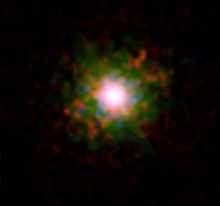- Circinus X-1
-
Circinus X-1 is an X-ray binary star system that includes a neutron star. Observation of Circinus X-1 in July 2007 revealed the presence of X-ray jets normally found in black hole systems; it is the first of the sort to be discovered that displays this similarity to black holes.
Contents
Location
On June 14, 1969, an Aerobee 150 rocket, launched from Natal, Brazil, obtained X-ray data during a scan of the Norma-Lupus-Circinus region that detected a well-isolated source at ℓ = 321.4±0.9° b = -0.5±2° (galactic), RA 15h 14m Dec -57° 49′ within the constellation Circinus and referred to as Circinus XR-1 (Cir XR-1).[1]
It was detected by Uhuru at 4U 1516-56 (3U 1516-56).
Intensity
A 685 ms periodicity for Cir X-1 (10 % of source intensity) had been suggested on the basis of rocket data.[1] Large intensity variations on time scales of seconds have been observed.[2]
Visual counterpart
The visual counterpart for Cir XR-1 (now Cir X-1) is BR Cir. The binary nature of Cir X-1 was established.[2]
Theoretical X-ray astrophysics
The X-ray source is assumed to be a neutron star as part of a low-mass X-ray binary (LMXB), type-I X-ray burster.[3]
See also
- X-1 X-ray source
References
- ^ a b Margon B, Lampton M, Bowyer S, Cruddace R (Oct 1971). "A Pulsing X-Ray Source in Circinus". Ap J. 169 (10): L23–5. Bibcode 1971ApJ...169L..23M. doi:10.1086/180806.
- ^ a b Jones C, Tananbaum H, Giacconi R (1973). 141st Meeting Amer Astron Soc (Tucson, Arizona).
- ^ Mignani RP, De Luca A, Caraveo PA, Mirabel IF (2002). "HST observations rule out the association between Cir X-1 and SNR G321.9-0.3". Astron Astrophys. 386 (2): 487–91. arXiv:astro-ph/0202268. Bibcode 2002A&A...386..487M. doi:10.1051/0004-6361:20020224. http://cat.inist.fr/?aModele=afficheN&cpsidt=13588025.
- "Circinus X-1: Neutron Stars Join the Black Hole Set". Chandra X-Ray Observatory. Harvard University / National Aeronautics and Space Administration. 2007. http://chandra.harvard.edu/photo/2007/cirx1/. Retrieved 8 January 2009.
External links
Categories:- X-ray binaries
- Multiple star stubs
Wikimedia Foundation. 2010.

